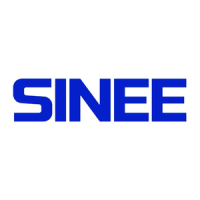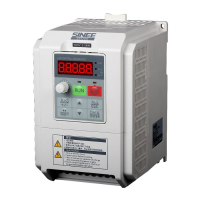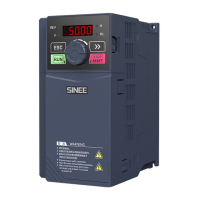Do you have a question about the Sinee EM303A-1R1-1CB and is the answer not in the manual?
Details the enhancements and new features introduced in the EM303A series inverter.
Provides essential instructions and warnings before operating the inverter.
Highlights critical electrical hazards and necessary precautions during wiring.
Outlines procedures for maintaining and inspecting the inverter.
Details the models and technical specifications for specific EM303A series inverters.
Lists EM303A models and their key technical specifications.
Describes the Process PID control modes for temperature, pressure, and flow.
Explains the SVC0 control mode for open-loop vector control without PG feedback.
Guides on checking and verifying the EM303A product upon delivery.
Details environmental and site requirements for proper inverter installation.
Illustrates the connections between the EM303A and its peripheral devices.
Shows the layout and identification of main circuit terminal blocks.
Guidance on installing a circuit breaker for input power protection.
Details the functions and wiring of control circuit terminals.
Describes the keypad layout and the function of each button.
Step-by-step guide for performing initial trial operations of the inverter.
Critical steps and checks to perform before powering off the inverter.
Explains the structure and conventions used in parameter tables.
Detailed description of general parameters for Group F0.
Defines the start mode for the inverter, including normal and speed search starts.
Configures the function of the JOG/+- buttons on the keypad.
Controls parameter setting access, allowing or locking edits.
Handles external fault signals, stopping the inverter and entering fault status.
Maps terminals to preset speed settings for flexible speed control.
Sets the DC brake torque proportion at start-up.
Defines the waiting time for DC brake activation at stop.
Enables slip compensation for V/F control to maintain speed under load.
Explains proportional control, a basic PID component.
Selects the regular setting mode for PID control.
Sets PID control to positive or negative mode for error handling.
Sets the proportion gain for PID close-loop control.
Explains torque control functionality in SVC1 mode.
Sets the gain for torque current.
Monitors the present output frequency of the inverter.
Explains the requirement and process for autotuning motor parameters.
Specifies that autotuning requires keypad control mode (F0-04=0).
Describes automatic torque boost and slip compensation features.
Lists common trip codes, their causes, and corrective actions.
Analyzes issues related to incorrect parameter settings and editing.
Discusses causes and solutions for inverter overheating.
Addresses issues related to mechanical vibration and resonance.
Details daily checks to ensure proper inverter operation.
Guidelines for periodic maintenance and replacing internal parts.
Information on optional keypad extension wires.
Defines the scope and network types supported by the protocol.
Details the frame structure for writing single parameters via ModBus.
Protocol command for circuit diagnosis and setting operations.
Explains the address code for slave inverters in the network.
Defines control commands for inverter operations.
Details the enhancements and new features introduced in the EM303A series inverter.
Provides essential instructions and warnings before operating the inverter.
Highlights critical electrical hazards and necessary precautions during wiring.
Outlines procedures for maintaining and inspecting the inverter.
Details the models and technical specifications for specific EM303A series inverters.
Lists EM303A models and their key technical specifications.
Describes the Process PID control modes for temperature, pressure, and flow.
Explains the SVC0 control mode for open-loop vector control without PG feedback.
Guides on checking and verifying the EM303A product upon delivery.
Details environmental and site requirements for proper inverter installation.
Illustrates the connections between the EM303A and its peripheral devices.
Shows the layout and identification of main circuit terminal blocks.
Guidance on installing a circuit breaker for input power protection.
Details the functions and wiring of control circuit terminals.
Describes the keypad layout and the function of each button.
Step-by-step guide for performing initial trial operations of the inverter.
Critical steps and checks to perform before powering off the inverter.
Explains the structure and conventions used in parameter tables.
Detailed description of general parameters for Group F0.
Defines the start mode for the inverter, including normal and speed search starts.
Configures the function of the JOG/+- buttons on the keypad.
Controls parameter setting access, allowing or locking edits.
Handles external fault signals, stopping the inverter and entering fault status.
Maps terminals to preset speed settings for flexible speed control.
Sets the DC brake torque proportion at start-up.
Defines the waiting time for DC brake activation at stop.
Enables slip compensation for V/F control to maintain speed under load.
Explains proportional control, a basic PID component.
Selects the regular setting mode for PID control.
Sets PID control to positive or negative mode for error handling.
Sets the proportion gain for PID close-loop control.
Explains torque control functionality in SVC1 mode.
Sets the gain for torque current.
Monitors the present output frequency of the inverter.
Explains the requirement and process for autotuning motor parameters.
Specifies that autotuning requires keypad control mode (F0-04=0).
Describes automatic torque boost and slip compensation features.
Lists common trip codes, their causes, and corrective actions.
Analyzes issues related to incorrect parameter settings and editing.
Discusses causes and solutions for inverter overheating.
Addresses issues related to mechanical vibration and resonance.
Details daily checks to ensure proper inverter operation.
Guidelines for periodic maintenance and replacing internal parts.
Information on optional keypad extension wires.
Defines the scope and network types supported by the protocol.
Details the frame structure for writing single parameters via ModBus.
Protocol command for circuit diagnosis and setting operations.
Explains the address code for slave inverters in the network.
Defines control commands for inverter operations.
| Input Voltage | 220-240 V AC |
|---|---|
| Output Voltage | 220-240 V AC |
| Phase | Single Phase |
| Output Frequency | 50Hz / 60Hz |
| Efficiency | ≥90% |
| Protection Features | Overload, Short Circuit |












